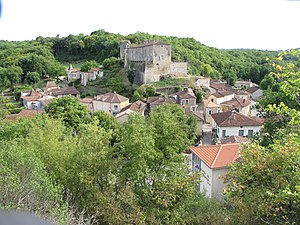Blanquefort-sur-Briolance
| Blanquefort-sur-Briolance | ||
|---|---|---|
|
|
||
| region | Nouvelle-Aquitaine | |
| Department | Lot-et-Garonne | |
| Arrondissement | Villeneuve-sur-Lot | |
| Canton | Le Fumélois | |
| Community association | Fumel Vallée du Lot | |
| Coordinates | 44 ° 36 ′ N , 0 ° 58 ′ E | |
| height | 104-274 m | |
| surface | 41.93 km 2 | |
| Residents | 470 (January 1, 2017) | |
| Population density | 11 inhabitants / km 2 | |
| Post Code | 47500 | |
| INSEE code | 47029 | |
| Website | www.blanquefortsurbriolance.fr | |
 View of Blanquefort-sur-Briolance |
||
Blanquefort-sur-Briolance is a French commune of 470 inhabitants (at January 1, 2017) in the department of Lot-et-Garonne in the region Nouvelle-Aquitaine (before 2016: Aquitaine ). The municipality belongs to the arrondissement of Villeneuve-sur-Lot and the canton of Le Fumélois (until 2015: canton of Fumel ).
The name in the Occitan language is Blancafort ( German white fortress ). In the Middle Ages, the land that is now the municipality was dependent on the Blanquefort family, a powerful family from the Médoc , whose name they eventually adopted.
The inhabitants are called Blanquefortais and Blanquefortaises .
geography
Blanquefort-sur-Briolance is about 30 km northeast of Villeneuve-sur-Lot in the historic province of Agenais on the northern border with the neighboring Dordogne department .
Blanquefort-sur-Briolance is surrounded by the eight neighboring municipalities:
|
Soulaures (Dordogne) |
Mazeyrolles (Dordogne) |
Lavaur (Dordogne) |
| Lacapelle-Biron |

|
Sauveterre-la-Lémance |
| Gavaudun | Cuzorn | Saint-Front-sur-Lémance |
Blanquefort-sur-Briolance lies in the catchment area of the Garonne River .
Tributaries of the Lot irrigate the territory of the municipality,
- the Lède , which rises in Blanquefort-sur-Briolance, and
- the Lémance with its tributaries,
- the Rivièrette and
- the Briolance with its tributaries,
- the Ruisseau de Canut, which rises in Blanquefort-sur-Briolance, and
- the Ruisseau de Naugarède, which rises in Blanquefort-sur-Briolance.
The highest point of the department lies in the northern municipality area at 274 m .
history
The archaeological site near the hamlet of Borie del Rey documents an early settlement of the area near the Périgord Noir during the Mesolithic .
Finds on the hill on which the parish church of Notre-Dame is located suggest that this place was settled in the High Middle Ages . This is believed to be related to the extraction of wood and iron, which are widespread resources in the area, and may not have resulted in regular settlement.
One of the first villages developed around a church from the 11th century on the territory of the parish of Veyrines. This was undoubtedly the first church in the parish of Blanquefort before the Notre-Dame parish church was built . This was built at the beginning of the 12th century and is connected to the Cayla settlement with the site of a first castle and the development of a second village. At the beginning of the 13th century, the castle was replaced by a larger complex, which was built on a rock spur further down from Cayla. A concentrically laid out village then developed below the castle in the valley.
The arrival of the Benedictines to the parish of La Sauvetat at the end of the 11th century led to the creation of a monastery village under the Abbey of La Sauve-Majeure and a village center around the church of Notre-Dame de La Sauvetat . The same development took place in the 12th century with the establishment of the parish of Saint-Chaliès.
The village of Cayla was abandoned in the 18th century, the villages of Blanquefort, La Sauvetat and Saint-Chaliès were united under the name Blanquefort on the eve of the French Revolution . The addition "sur-Briolance" was added in 1919.
Population development
After records began, the population rose to a peak of around 1800 by the middle of the 19th century. In the following period, the size of the community fell to around 470 inhabitants during short recovery phases until the 1990s, before it stabilized at this level.
| year | 1962 | 1968 | 1975 | 1982 | 1990 | 1999 | 2006 | 2011 | 2017 |
|---|---|---|---|---|---|---|---|---|---|
| Residents | 727 | 666 | 587 | 549 | 468 | 492 | 499 | 515 | 470 |
Culture and sights
Buildings
- Parish Church of Notre-Dame from the 12th century, inscribed as a monument historique
- Parish church in Saint-Chaliès from the 12th century
- Parish church of Sainte-Madeleine in La Sauvetat from the 12th century
- Church ruins of Saint-Martin in the hamlet of Veyrines from the 11th century
- Blanquefort Castle from the 12th century, inscribed as a Monument historique
- Latour mansion in La Sauvetat from the 15th century
- 19th century blast furnace , later a flour mill on the site, then a lemonade factory
- 16th century farms in La Sauvetat
Culture
The municipality has an entry in the national list of intangible cultural heritage .
The practice of collecting eggs was maintained until the 1980s. A group of young men went from farm to farm to get chicken eggs. At the last house an omelette was baked from the booty . The choice of the last house fell on the apartment of a young lady who was to be married. There were also arguments between the groups who threw eggs at each other.
During the carnival season until the 1960s, the children fetched old clothes from the attics and went through the village dressed up with handcrafted masks to get sweets . These customs are brought back to life through a revival of the All Saints' Day customs mixed with those of the Carnival. Masked and costumed children and adults march through the village with musicians dressed in pumpkins and candles, in order to then celebrate in the only bar-restaurant over a joint meal.
Economy and Infrastructure

total = 52
education
The municipality has a public pre-school and elementary school with 24 students in the 2018/2019 school year.
traffic
Blanquefort-sur-Briolance can be reached via Routes départementales 240, 426 and 710, the former Route nationale 710 .
Line 48 of the TER Nouvelle Aquitaine , a regional train of the national SNCF , which operates the route from Périgueux to Agen , crosses the southern municipality. The nearest stop is in the neighboring municipality of Sauveterre-la-Lémance.
Personalities
Pierre-Sylvain Régis, born in La Sauvetat in 1632, died in Paris on January 11, 1707 , was a French philosopher , member of the Académie des sciences between 1699 and 1707 and a follower of Cartesianism .
Web links
- Blanquefort-sur-Briolance on the association's website (French)
- TER Nouvelle Aquitaine website (French)
Individual evidence
- ^ Ernest Nègre: Toponymie générale de la France ( fr ) Librairie Droz, Geneva. S. 1479. 1998. Retrieved February 1, 2019.
- ↑ a b c d Blanquefort-sur-Briolance ( fr ) Conseil régional d'Aquitaine. Archived from the original on September 9, 2016. Retrieved February 1, 2019.
- ↑ Ma commune: Blanquefort-sur-Briolance ( fr ) Système d'Information sur l'Eau du Bassin Adour Garonne. Retrieved February 1, 2019.
- ↑ Un fer à bœuf dans les lames de mon taille-haie ( fr ) Municipality of Blanquefort-sur-Briolance. 2015. Accessed February 1, 2019.
- ↑ a b Notice Communale Blanquefort-sur-Briolance ( fr ) EHESS . Retrieved February 1, 2019.
- ↑ Populations légales 2016 Commune de Blanquefort-sur-Briolance (47029) ( fr ) INSEE . Retrieved February 1, 2019.
- ↑ Christine Escarmant-Pauvert: PCI à Blanquefort-sur-Briolance ( fr , PDF) Ministry of Culture . September 15, 2010. Retrieved February 1, 2019.
- ↑ Caractéristiques des établissements en 2015 Commune de Blanquefort-sur-Briolance (47029) ( fr ) INSEE . Retrieved February 1, 2019.
- ^ École maternelle et élémentaire ( fr ) National Ministry of Education. Retrieved February 1, 2019.
- ^ George Sauvage: Pierre-Sylvain Régis ( en ) In: The Catholic Encyclopedia . New Advent. 1911. Retrieved February 1, 2019.
- ↑ Pierre-Sylvain Régis (1632–1707) ( fr ) Bibliothèque nationale de France . Retrieved February 1, 2019.








